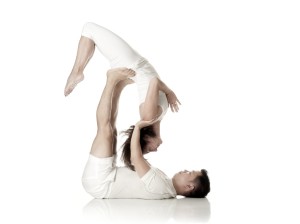Click here for: Wellness Program l Yoga l Research & Studies

HA! Ask 10 yoga teachers that question, you’ll get 20 answers…here is a BRIEF explanation of my understanding, I am sure others will add or subtract information…
Hatha yoga is a general term that refers to the practice of physical yoga postures. The word is made of two roots HA meaning sun, and THA meaning moon. The idea of Hatha yoga practice is to restore balance to the body (sun and moon like yin and yang=balanced). In North American yoga studios and YMCA’s, Hatha has come to mean a class where postures are performed to achieve harmony in body, mind and spirit. These classes could be considered “average” as far as physical exertion goes. Poses are not necessarily linked one to the next in this practice.
In North America, Vinyasa classes use the same poses as Hatha Yoga (please note, Vinyasa Yoga is also Hatha Yoga), but this approach, weaves them together, moving from one posture to another as a flowing sequence. These classes tend to be more “vigorous”.
In Ashtangha Vinyasa (in the tradition of Pathabbi Jois), there is a specific sequence of Hatha yoga postures taught, each flowing into the next. There are six different sequences, but most teachers only teach poses from the “primary” or first series and second series. These sequences are “very vigorous”.
Restorative Yoga is a very gentle practice where postures are meant to be done fully supported by props such as blankets, bolsters, blocks and straps. Once set up in a pose, you should be able to release all the muscles in the body into a passive stretch. Poses are often held for 10 minutes each per side, and this practice should be considered safe for “all” participants. These are the slowest classes (least vigorous) of all styles.
Yin Yoga, is similar to restorative (long holds, gentle poses, with little muscular effort), the only difference is that props are not necessarily used in Yin Yoga, and the focus of the practice is heavily influenced by Traditional Chinese Medecine ideas regarding energy meridians etc (think acupuncture).
I’ll let Simran give you an explanation of Kundalini yoga (in the tradition of Yogi Bhajan)…
I hope that answers your question, or at least makes you confused enough to come to some classes. “Yoga” means many things to many people.
smiles
—————
John Veiga: His private practice in Thai Yoga Massage compliments his knowledge of Ashtanga, and Iyengar yoga